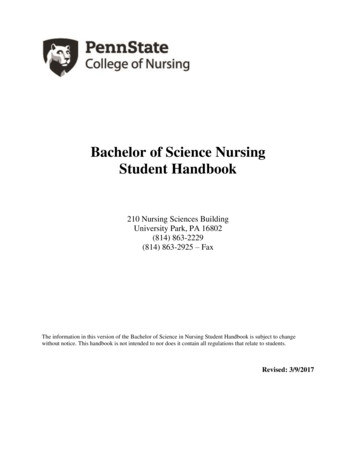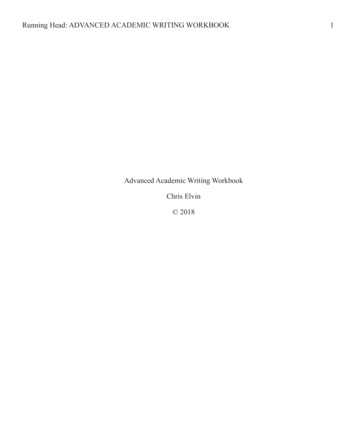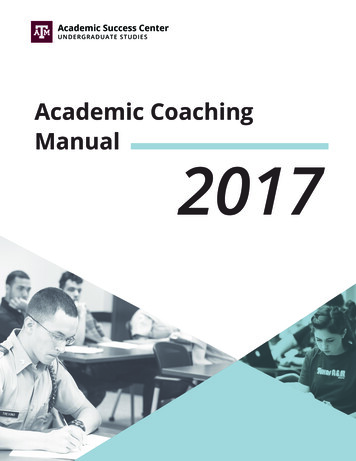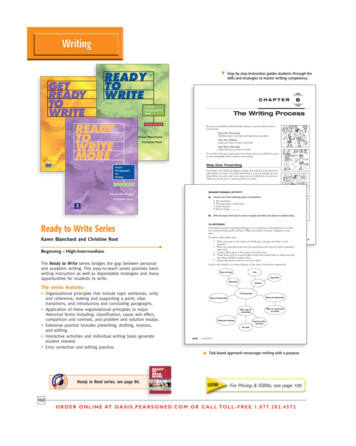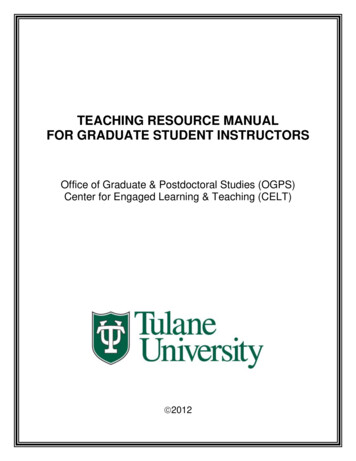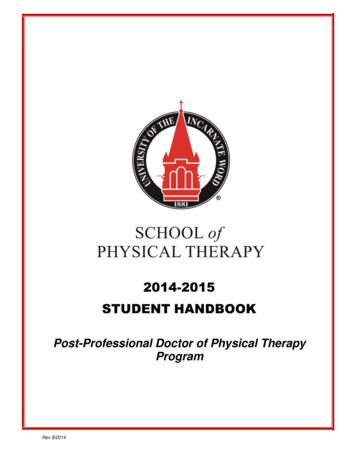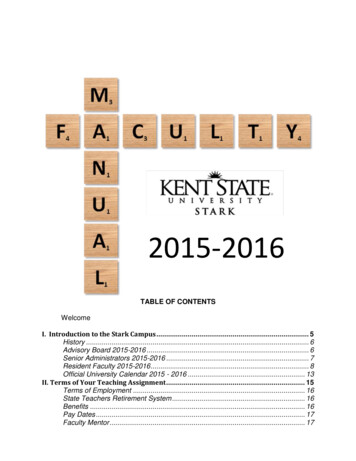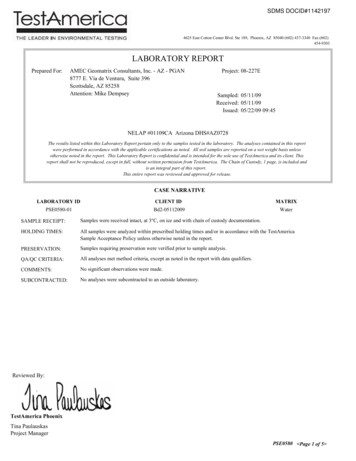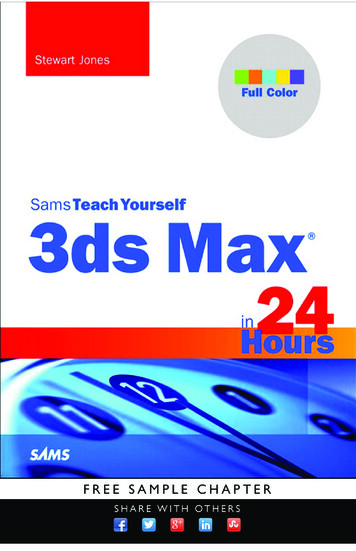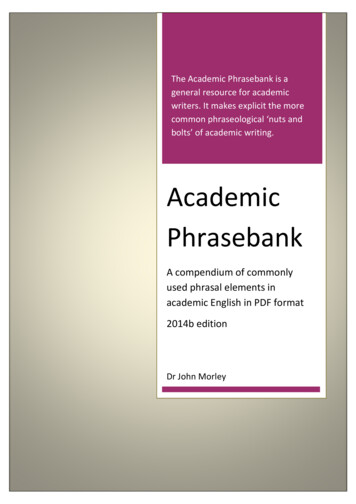
Transcription
The Academic Phrasebank is ageneral resource for academicwriters. It makes explicit the morecommon phraseological ‘nuts andbolts’ of academic writing.AcademicPhrasebankA compendium of commonlyused phrasal elements inacademic English in PDF format2014b editionDr John Morley
PDF Download version 2014 The University of Manchester1 Page
PrefaceThe Academic Phrasebank is a general resource for academic writers. It aims to provide thephraseological ‘nuts and bolts’ of academic writing organised according to the main sections of aresearch paper or dissertation. Other phrases are listed under the more general communicativefunctions of academic writing.The resource was designed primarily for academic and scientific writers who are non-native speakersof English. However, native speaker writers may still find much of the material helpful. In fact, recentdata suggests that the majority of users are native speakers of English.The phrases, and the headings under which they are listed, can be used simply to assist you inthinking about the content and organisation of your own writing, or the phrases can be incorporatedinto your writing where this is appropriate. In most cases, a certain amount of creativity andadaptation will be necessary when a phrase is used.The Academic Phrasebank is not discipline specific. Nevertheless, it should be particularly useful forwriters who need to report their empirical studies. The phrases are content neutral and generic innature; in using them, therefore, you are not stealing other people's ideas and this does notconstitute plagiarism.In the current PDF version, additional material, which is not phraseological, has been incorporated.These additional sections should be helpful to you as a writer.2 Page
ContentsIntroduction: About Academic Phrasebank4-5Major SectionsIntroducing workReferring to literatureDescribing methodsReporting resultsDiscussing findingsWriting conclusions7 – 1213 - 1819 - 2223 - 2627 - 3031 - 34General FunctionsBeing criticalBeing cautiousClassifying and listingCompare and contrastDefining termsDescribing trendsDescribing quantitiesExplaining causalityGiving examples as supportSignalling transitionWriting about the past36 - 3839 - 4142 - 4344 - 4546 - 47484950 - 5152 - 5354 - 5556 - 57Notes on Academic WritingAcademic styleCommonly confused wordsBritish and US spellingPunctuationUsing articlesSentence structureParagraph structureHelpful tips for writers59 - 6162 - 63646566 - 6768 - 697071 - 723 Page
About Academic PhrasebankTheoretical InfluencesThe Academic Phrasebank largely draws on an approach to analysing academic texts originallypioneered by John Swales in the 1980s. Utilising a genre analysis approach to identify rhetoricalpatterns in the introductions to research articles, Swales defined a ‘move’ as a section of text thatserves a specific communicative function (Swales, 1981,1990). This unit of rhetorical analysis is usedas one of the main organising sub-categories of the Academic Phrasebank. Swales not only identifiedcommonly-used moves in article introductions, but he was interested in showing the kind oflanguage which was used to achieve the communicative purpose of each move. Much of thislanguage was phraseological in nature.The resource also draws upon psycholinguistic insights into how language is learnt and produced. Itis now accepted that much of the language we use is phraseological in nature; that it is acquired,stored and retrieved as pre-formulated constructions (Bolinger, 1976; Pawley and Syder, 1983).These insights began to be supported empirically as computer technology permitted theidentification of recurrent phraseological patterns in very large corpora of spoken and writtenEnglish using specialised software (e.g. Sinclair, 1991). Phrasebank recognises that there is animportant phraseological dimension to academic language and attempts to make examples of thisexplicit.Sources of the phrasesThe vast majority of phrases in this resource have been taken from authentic academic sources. Theoriginal corpus from which the phrases were ‘harvested’ consisted of 100 postgraduate dissertationscompleted at the University of Manchester. However, phrases from academic articles drawn from abroad spectrum of disciples have also been, and continue to be, incorporated. In most cases, thephrases have been simplified and where necessary they have been ‘sifted’ from their particularisedacademic content. Where content words have been included for exemplificatory purposes, these aresubstitutions of the original words. In selecting a phrase for inclusion into the Academic Phrasebank,the following questions are asked: does it serve a useful communicative purpose in academic text?does it contain collocational and/or formulaic elements?are the content words (nouns, verbs, adjectives) generic in nature?does the combination ‘sound natural' to a native speaker or writer of English?When is it acceptable to reuse phrases in academic writing?In a recent study (Davis and Morley, 2013), 45 academics from two British universities weresurveyed to determine whether reusing phrases was a legitimate activity for academic writers, and ifso, what kind of phrases could be reused. From the survey and later from in-depth interviews, thefollowing characteristics for acceptability emerged. A reused phrase: should not have a unique or original construction;should not express a clear point of view of another writer;depending on the phrase, may be up to nine words in length; beyond this 'acceptability'declines;may contain up to four generic content words (nouns, verbs or adjectives which are notbound to a specific disciplinary domain).4 Page
Some of the entries in the Academic Phrasebank, contain specific content words which have beenincluded for illustrative purposes. These words should be substituted when the phrases are used. Inthe phrases below, for example, the content words in bold should be substituted: X is a major public health problem, and the cause of .X is the leading cause of death in western-industrialised countries.The many thousands of disciplinary-specific phrases which can be found in academic communicationcomprise a separate category of phrases. These tend to be shorter than the generic phrases listed inAcademic Phrasebank, and typically consist of noun phrases or combinations of these. Acceptabilityfor reusing these is determined by the extent to which they are used and understood by members ofa particular academic community.Further workDevelopment of the website content is ongoing. In addition, research is currently being carried outon the ways in which experienced and less-experienced writers make use of the AcademicPhrasebank. Another project is seeking to find out more about ways in which teachers of English foracademic purposes make use of this resource.References Bolinger, D. (1976) ‘Meaning and memory’. Forum Linguisticum, 1, pp. 1–14.Davis, M. and Morley, J. (2013) 'Use your own words: Exploring the boundaries of plagiarism'.In EAP within the higher education garden: Cross-pollination between disciplines,departments and research, John Wrigglesworth (Ed.). Proceedings of the BALEAP Conference,Portsmouth 2011. Reading: Garnet Education.Hopkins, A. & Dudley-Evans, A. (1988). ‘A genre-based investigations of the discussionssections in articles and dissertation’. English for Specific Purposes, 7(2), 113-122.Pawley, A. and Syder, F.H. (1983). ‘Two puzzles for linguistic theory: nativelike selection andnativelike fluency’. In: Richards, J.C. and Schmidt, R.W. (Eds.), Language and Communication,pp. 191-226. Longman: New York.Sinclair, J. (1991) Corpus, concordance, collocation. Oxford: Oxford University Press.Swales, J. (1981). Aspects of article introductions (Aston ESP Research Report No. 1).Birmingham: Language Studies Unit: University of Aston.Swales, J. (1990). Genre analysis: English in academic and research settings. Cambridge:Cambridge University Press.5 Page
Major sections6 Page
Writing IntroductionsThere are many ways to introduce an academic essay or short paper. Most academic writers,however, appear to do one or more of the following in their introductions: establish the context, background and/or importance of the topicindicate an issue, problem, or controversy in the field of studydefine the topic or key termsstate of the purpose of the essay/writingprovide an overview of the coverage and/or structure of the writingIntroductions to research articles and dissertations tend to be relatively short but quite complex.Some of the more common moves include: establishing the context, background and/or importance of the topicgiving a brief synopsis of the relevant literatureindicating a problem, controversy or a knowledge gap in the field of studyestablishing the desirability of the researchlisting the research questions or hypothesesproviding a synopsis of the research method(s)explaining the significance or value of the studydefining certain key termsproviding an overview of the dissertation or report structureexplaining reasons for the writer's personal interest in the topicExamples of phrases which are commonly employed to realise these functions are listed below.Note that there may be a certain amount of overlap between some of the categories under whichthe phrases are listed.Establishing the importance of the topic for the world or societyX is a fundamental property of .X is fast becoming a key instrument in .X is a common disorder characterised by .X plays an important role in the maintenance of .Xs are the most potent anti-inflammatory agents known.X is a major public health problem, and the main cause of .Xs are one of the most rapidly declining groups of insects in .In the new global economy, X has become a central issue for .X is the leading cause of death in western-industrialised countries.Xs are one of the most widely used groups of antibacterial agents and .X is increasingly recognised as a serious, worldwide public health concern.X is an important component in the climate system, and plays a key role in Y.In the history of development economics, X has been thought of as a key factor in .Establishing the importance of the topic for the disciplineA key aspect of X is .X is a classic problem in .A primary concern of X is .X is at the heart of our understanding of .X is an increasingly important area in applied linguistics.7 Page
Investigating X is a continuing concern within .Central to the entire discipline of X is the concept of .X and Y have been an object of research since the 1960sX is a major area of interest within the field of .The issue of X has received considerable critical attention.X has been studied by many researchers using .One of the most significant current discussions in legal and moral philosophy is Establishing the importance of the topic (time frame given)One of the most important events of the 1970s was .Traditionally, Xs have subscribed to the belief that .Recent developments in X have heightened the need for .In recent years, there has been an increasing interest in .Recent trends in X have led to a proliferation of studies that .Recent developments in the field of X have led to a renewed interest in .Recently, researchers have shown an increased interest in .The past decade has seen the rapid development of X in many .The past thirty years have seen increasingly rapid advances in the field of .Over the past century there has been a dramatic increase in .X proved an important literary genre in the early Y community.The changes experienced by Xs over the past decade remain unprecedented.Xs are one of the most widely used groups of Y and have been extensively used for .Synopsis of literaturePrevious studies have reported .Recent evidence suggests that .Several attempts have been made to .Studies of X show the importance of .A number of researchers have reported .Recently investigators have examined the effects of X on Y.Factors found to be influencing X have been explored in several studies.In the past two decades a number of researchers have sought to determine .A considerable amount of literature has been published on X. These studies .Surveys such as that conducted by Smith (1988) showed that .The first serious discussions and analyses of X emerged during the 1970s with .There have been a number of longitudinal studies involving X that have reported .Xs were reported in the first models of Y (e.g., Smith, 1977; Smith and Patel, 1977).What we know about X is largely based upon empirical studies that investigate how .Smith (1984: 217) shows how, in the past, research into X was mainly concerned with .Highlighting a problemHowever, a major problem with this kind of application is .Lack of X has existed as a health problem for many years.However, these rapid changes are having a serious effect on .Despite its safety and efficacy, X suffers from several major drawbacks:However, research has consistently shown that these students lack .There is increasing concern that some Xs are being disadvantaged .Despite its long clinical success, X has a number of problems in use.Questions have been raised about the safety of prolonged use of .Along with this growth in X, however, there is increasing concern over .8 Page
Highlighting a controversy in the field of studyTo date there has been little agreement on what .One major issue in early X research concerned .The issue has grown in importance in light of recent .One observer has already drawn attention to the paradox in .Questions have been raised about the safety of prolonged use of .Debate continues about the best strategies for the management of .In many Xs, a debate is taking place between Ys and Zs concerning .This concept has recently been challenged by X studies demonstrating .The debate about X has gained fresh prominence with many arguing that .More recently, literature has em
Other phrases are listed under the more general communicative functions of academic writing. The resource was designed primarily for academic and scientific writers who are non-native speakers of English. However, native speaker writers may still find much of the material helpful. In fact, recent data suggests that the majority of users are native speakers of English. The phrases, and the .
